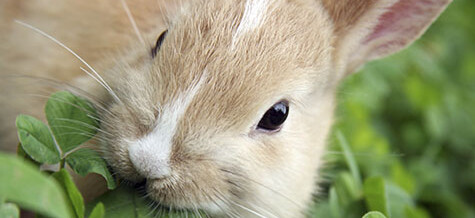
“Flopsy, Mopsy, and Cotton-tail, who were good little bunnies, went down the lane to gather blackberries. But Peter, who was very naughty, ran straight away to Mr. McGregor’s garden and squeezed under the gate! First he ate some lettuces and some French beans. And then he ate some radishes. And then, feeling rather sick, he went to look for some parsley.” – Beatrix Potter, The Tale of Peter Rabbit.

While they are cute, no one likes them eating our tulips!
If any of you are gardeners like I am, I’m sure you have your own “tales” of finding your tulips or other garden plants mowed down by these darling, soft, furry little creatures. You get through a winter with protecting bulbs from the ever-hungry squirrels only to discover the buds nipped off in the spring by the neighborhood rabbits. Worse yet, you see a thriving plant one day and a decimated one the next, while you’ve waited so patiently for a bloom! ARGH!
The favorite feeding time for rabbits is overnight, (how convenient) so what to do? There are many toxic repellents on the market but I personally don’t advocate them, especially trapping or killing these cute, but pesky critters. Last week, after noticing that a grouping of our tulip beds had been devoured as a delicious salad mix, I quickly grabbed some lavender hydrating mist I use and gave each tulip a good spritz.
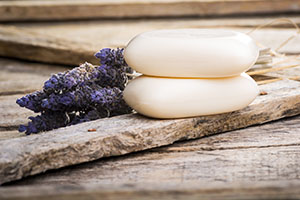
Organic soap and lavender are natural rabbit repellents.
In addition, I grabbed a brush and our 3 year-old lab, Daisy, and managed to get a good three handfuls of her fur off and spread that out in the beds. Two easy, non-toxic wabbit wepellants!
Here are some other terrific non-toxic suggestions for keeping these pesky critters out of your garden:
Do It Yourself Home Remedies
The most important thing with these homemade remedies is that you must reapply after every rain, or they lose their effectiveness.
- Grate soap with a cheese grater, and spread over the planted areas.
- Soak used ½ corn cobs in apple cider vinegar for 10 minutes, then scatter them throughout your garden. Repeat every two weeks.
- Combine crushed garlic, tabasco sauce, dishwashing liquid with water, and pour the solution around the flowers.
- Combine sliced chili, raw egg, black pepper (crushed or whole) with water, and pour the solution around the flowers.
- Mix in your blender: habanero peppers, garlic, red onion and peppermint oil.
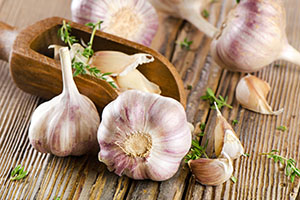
Garlic is in most homemade recipes and repels as a plant as well.
Click here for the recipe.
- Another touted recipe uses egg, milk, dish soap and lots of cloves. Click here for the recipe.
- Make your own homemade Garlic Oil – Super easy! Click here for the recipe.
Plants That Serve As Natural Repellents
- Planting garlic seeds 2” apart around the entire garden perimeter
- Planting marigold, daffodils and anything in the onion family near blooming bulbs and other plants
- In addition, rabbits tend to avoid:
- Vegetables – asparagus, potatoes, peppers, corn rhubarb, squash, cucumbers and tomatoes
-

Rabbits tend to leave geraniums alone in the garden.
Flowers – Cleomes, germaniums, vincas, lilac and wax begonias
- Herbs – Basil, mint, oregano, parsley, tarragon, lavender
Note: When I say “tend to avoid” there are always exceptions to the rules. There have been stories of friends’ tomatoes being chomped.
For a comprehensive list of other plants to consider as companion plants in your garden that rabbits tend to avoid, click here:
www.thriftyfun.com/Keeping-Rabbits-Out-of-Your-Garden.html
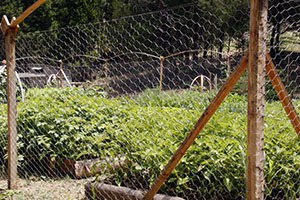
A good chicken-wire fence is the most effective way to keep most critters out.
Fencing
- While it’s the most effective method for keeping rabbits out of the garden, it can also expensive and labor intensive. Fencing is usually made of chicken wire, and should ideally be 2-3 feet high to prevent them from jumping over and it should also be buried at least 6 inches deep to keep the from burrowing under.
- Wire mesh cages can also be used, especially if you’re planting using containers.
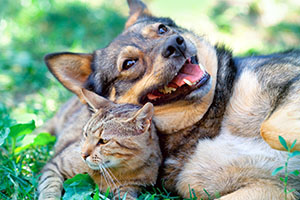
Cat and dog fur helps keep rabbits at bay.
Scare Tactics
- Keep your dog or cat outside near the beds
- Scatter dog, cat or human hair in the garden bed (Your local barber or hair salon should be happy to supply you with their clippings)
- Place a ceramic owl in the garden (owls are the natural enemy of the rabbit).
Non Toxic Repellents from the Garden Center
- Scattering dried bone blood meal around the plants
- Critter Ridder
- Capsaicin repellents cause a burning sensation that discourages browsing
- Hot Pepper Wax Animal Repellent
- Plantskydd – 100 percent organic and effective. Click the link to read more about this product: www.plantskydd.com
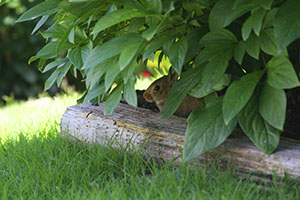
Low hanging branches can be perfect hiding places for rabbits.
Bottom Line: Look for products that contain organic or natural ingredients, are environmentally safe, biodegradable and won’t harm garden plants or animal life.
Habitat or Environment Control
- Keep an eye on attractive locations for rabbits to settle – piles of brush or leaves that have collected, in addition to low-growing branches and dense vegetation.
- Seal off openings beneath decks, steps and buildings.
I love that there really are a good range of non- toxic options to saving our efforts and bringing our gardens to fruition. It’s important to remember that toxic repellants have that trickle down effect; harsh, toxic chemicals may harm all of us in our living environments, especially our pets who are low to the ground. Contaminating our ground water with toxins isn’t a good thing, either.

Summer’s bounty: fresh organic vegetables!
Join me in being proactive this year in keeping our gardens healthy and thriving, not harming the bunny population and reaping the benefits of our gardening efforts in a non toxic way!
![]()
Sources:
Bonnie Plants
EHow
GardenWeb.com
Hicks Nurseries, Inc.
Home and Garden-Mick Telkamp
Horticulture Magazine
Houselogic
How To Hunt Rabbits
Thrifty Fun
If you “Like” this post, I’d be thrilled if you’d share it.
APR
